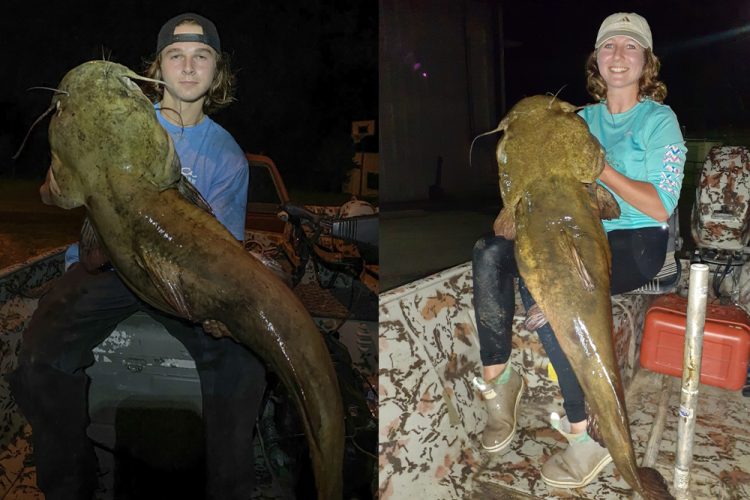Haylee and Logan Applegate caught 50-pound catfish from Lake Conway in Arkansas within days of one another.
Rebuilding a Legendary Flathead Lake
By Keith “Catfish” Sutton
Arkansas’ Lake Conway is about to undergo an extensive five-year renovation
For decades now, I’ve told anyone who would listen that Arkansas’ Lake Conway is one of the world’s best flathead catfish lakes. This 6,700-acre Arkansas Game & Fish Commission (AGFC) impoundment off Interstate 40 just west of Little Rock is the largest ever constructed by a state wildlife agency. Its waters are shallow, heavily timbered throughout, rich in shad and sunfish, and full of huge logjams and deep holes—in other words, prime habitat for producing giant flatheads.
Scores of 30- to 60-pound Conway flatheads are taken every year, some by anglers fishing for other species, some on trotlines or juglines and a few by rod-and-reel anglers who enjoy the challenge of battling big cats in heavy timber. Serious local catmen believe that 100-pounders swim there, but the dense timber makes it almost impossible to land one.
Recent evidence of the lake’s potential for producing giant flatties appeared in an April 2022 AGFC news release. In it, AGFC assistant chief of communications Randy Zellers wrote about brother and sister flathead wranglers Haylee and Logan Applegate of Jacksonville, Arkansas. Using juglines baited with live bluegills, these high-school students had recently caught two Lake Conway flatheads over 50 pounds within the span of just a few days. Their father Roger says he had previously hooked and lost one flathead there that he believed would have exceeded 80 pounds.
Reports like these are common, but for the next five or so years, folks who enjoy fishing in Lake Conway will have to do their angling elsewhere. Now 75 years old, this Natural State treasure is in need of rehabilitation, so the state Game & Fish Commission will completely draw down the lake to make some much-needed improvements, including replacement of the antiquated gates and spillway at the dam site, improvements to boat lanes through Conway’s stump-filled waters, enhancements to boat ramps and parking areas, and increased access for bank fishing.
Massive amounts of silt and sediment have built up on the lake’s bottom during the last 75 years. “Completely natural in many fertile fisheries, this byproduct of aging has taken away as much as three feet of depth in portions of the lake and smothered much of the lake’s prime fish spawning habitat,” said Zellers. “Many boat house owners in the northern quarter of the lake cannot access their boathouse by water any longer because of this buildup.
“An extended drawdown will allow the lakebed to dry out and compact, regaining as much as 1-1/2 feet of depth in some locations,” Zellers continued. “Once exposed to air, organic matter trapped in the sediment will decompose and be recycled into the system through the growth of grasses, vines and other vegetation.
“Drying of the lakebed and compaction of the silt also will promote more hard bottom areas and vegetation that is used by fish for spawning habitat. While the lake is full of stumps, more complex cover offered in natural woody vegetation serves much better as shelter for baitfish and young sportfish. Additionally, cypress trees that still live in the lake’s water should see a boost in growth from the temporary reprieve from flooding. This growth also will offer much more complex cover for fish than bare trunks and root systems.”
Lake Conway is in a very productive watershed, but the loss of spawning habitat and lake depth prevent the lake from living up to its true potential. This fertility has led to a large amount of nontarget roughfish such as gar, buffalo and bowfin in the lake. The 2019 flood of the Arkansas River may have intensified this problem when the river flowed backward over the gates of the current spillway and allowed an open door to more roughfish, which may have included invasive carp species.
Few new reservoirs are being built, both in Arkansas and across the country, so drawdowns for renovations provide a rare opportunity for biologists to hit the “reset” button on a fishery. Draining the lake will enable the AGFC to start with a clean slate and focus as much of the lake’s nutrients as possible toward desirable species. The lake’s fertility will then allow the fish to grow quickly, promoting a fast recovery post-renovation.
Hopefully, factors like these will benefit not only popular species like largemouth bass, crappie, bluegills and redear sunfish, but also top-tier predators like channel and flathead catfish. It remains to be seen how long it will take for the lake to start producing flatheads of a size that have made it perhaps the best flathead fishery in the country.
For more information, visit NewLakeConway.com.



